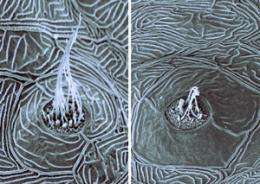Elusive protein points to mechanism behind hearing loss

(PhysOrg.com) -- A serendipitous discovery of deaf zebra fish larvae has helped narrow down the function of an elusive protein necessary for hearing and balance. The work, led by Rockefeller University’s A. James Hudspeth, suggests that hearing loss may arise from a faulty pathway that translates sound waves into electrical impulses the brain can understand.
“These zebrafish larvae were originally pegged for another study, but then we saw that one-fourth of them failed to respond to acoustic stimuli and made erratic spiraling movements, and that suggested that they were born deaf,” says first author Michelle R. Gleason, who spearheaded the project. “So we took this opportunity to examine what could be responsible for this extreme hearing loss.”
At first, Gleason and Hudspeth, head of the Laboratory of Sensory Neuroscience and a Howard Hughes Medical Institute investigator, didn’t detect any structural defects in the zebra fish’s inner ear, which houses sound sensors called hair cells. The cells are adorned with height-ordered hair-like projections called stereocilia, which, when deflected toward the tallest member, set in motion a series of events that decodes sounds into a neural code. “It was such a clean phenotype,” says Gleason. “Everything about the mutants’ inner ear seemed normal.”
But something was clearly amiss. Even though the deaf zebra fish had hair cells, several tests used to measure their presence and function made it seem as if these hair cells might as well not be there.
By comparing the genomes of normal zebra fish and the deaf ones, the team mapped the affected DNA and then zeroed in on the precise gene, which encodes for the protein Tmie. The gene had two mutations, resulting in a severely shortened protein that affected the function of the hair-like sensors, leading to hearing loss.
Using powerful electron microscopy techniques, Gleason and her colleagues confirmed previous findings in mice studies that showed abnormalities in the hair cells. The deaf zebra fish had fewer and shorter kinocilia as well as a reduced number of stereocillia. But the researchers also found that the tips of the stereocilia were much thinner than normal stereocilia and lacked a tethering protein that connects one stereocilium to the next. The findings, says Gleason, suggest that Tmie plays a bigger role in the transmission of sound than previously thought.
“At the ultra-structural level, we specifically show that these mutant defects map to a very specific cog in the transduction machinery,” says Gleason. “And that’s exciting because we now have a clearer target for therapy.
More information: Proceedings of the National Academy of Sciences online: November 23, 2009. The transmembrane inner ear (Tmie) protein is essential for normal hearing and balance in the zebrafish, Michelle R. Gleason, Aaron Nagiel, Sophie Jamet, Maria Vologodskaia, Hernán López-Schier and A.J. Hudspeth.
Provided by Rockefeller University (news : web)















